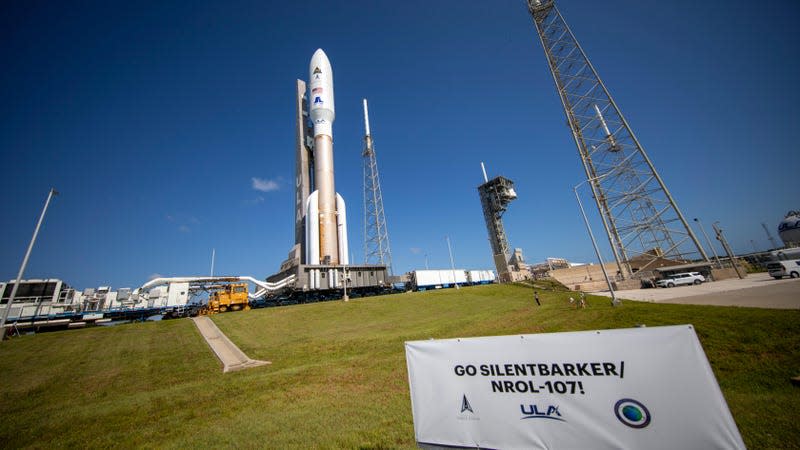ULA Set for Launch of Atlas 'Bruiser' Rocket for Space Force Threat Tracking Mission

The Alpha V rocket carrying the SILENTBARKER/NROL-107 mission sitting on a Cape Canaveral launch pad on August 25.Image: United Launch AllianceImage: ULA
Update: August 29, 8:13 a.m. ET: ULA announced last night through an emailed statement that the launch has been postponed indefinitely because of the approaching Hurricane Idalia, which was just recently upgraded from a tropical storm and is expected to make landfall in Florida on Wednesday morning. ULA also said in the statement that the rocket and payload have been returned to the base’s vertical integration facility.
Original article follows.
Read more
Chess World's 'Anal Bead' Cheating Saga Quietly Comes To An End
Amy Coney Barrett Thinks People Have 'Misimpressions' of the Supreme Court
Retired Judge Pinpoints 'Stunningly Stupid' Moment Trump's Legal Team Lost a Hearing
You Don't Need A Massive Battery, Or Fast Charging To Give Up Gas
Launch is currently scheduled for 8:34 a.m. ET on August 29. A ULA live feed, provided below, is scheduled to begin streaming at 8:15 that morning. However, the incoming Tropical Storm Idalia may pose a threat to Tuesday’s launch as the storm is set to be upgraded to a hurricane before it makes landfall in Florida on Wednesday morning.
“SILENTBARKER/NROL107 will strengthen the NRO’s ability to provide a wide range of timely intelligence information to national decision makers, warfighters and intelligence analysts to protect the nation’s vital interests and support humanitarian efforts worldwide,” ULA said on its website.
The Atlas V’s RD-180 engine system—which features a single engine and two thrust chambers—will launch the the Silent Barker payload into orbit. The rocket will burn highly-purified kerosene known as Rocket Propellant-1 and liquid oxygen to create over 860,000 pounds of thrust. Five boosters will each provide over an additional 371,000 pounds of thrust; ULA refers to this particular Atlas kit as the “bruiser” configuration, as it’s the most powerful variation of the rocket. The Silent Barker satellite will rest inside a 16-foot-long (5-meter-long) sandwich-style payload fairing that is meant to split apart when the launch reaches its final stage.
Increased space domain awareness is an important goal for the U.S. Space Force as the military branch continues to assert the country’s presence in orbit. Managing threats from other countries during wartime is an indelible aspect of space domain awareness, but Space Force has another, more pressing obstacle to overcome: space junk.
The European Space Agency estimated in December 2022 that there were 32,300 pieces of debris—everything from spent rocket stages to flecks of paint—currently orbiting Earth, with potentially millions more that haven’t been tracked. According to NASA, pieces of space debris can reach speeds up to 17,500 miles per hour (28,160 kilometers per hour), orbiting Earth once every 90 minutes. Space debris can completely incapacitate a satellite or mission traversing through orbit, so characterizing those pieces of debris and anticipating where they may move is of utmost concern for space-faring nations and companies across the board.
For more spaceflight in your life, follow us on Twitter and bookmark Gizmodo’s dedicated Spaceflight page.
More from Gizmodo
9 PC Games You Need To Play During Steam’s Latest Strategy Fest Sale
Parents Credit the Janitors at UNC Chapel Hill for Saving Their Children's Lives During Shooting
Sign up for Gizmodo's Newsletter. For the latest news, Facebook, Twitter and Instagram.

